Cerabyte Transformative Ceramic-Based Technology for Accessible Permanent Storage
Expands into USA with offices in Silicon Valley, CA, and Boulder, CO.
This is a Press Release edited by StorageNewsletter.com on July 26, 2024 at 2:01 pmCerabyte GmbH (Ceramic Data Solutions Holding GmbH) announced its expansion into USA with its accessible permanent storage technology.
Squared glass carrier with dark ceramic nano coating
The technology uses cost-efficient flexible glass material and offers fast write/read with high storage capacity. The company has established offices in Silicon Valley, CA, and Boulder, CO.
The firm’s solution can store data for virtually unlimited time and reduce data center storage TCO by orders of magnitude. Due to its media longevity and rapid access, the company also solves the challenges of long-term archival storage, enabling the implementation of fast-retrieval active archive solutions and eliminating the need to periodically migrate data from one media to another.
“Cerabyte’s emerging and disruptive technology is currently the most exciting development in digital data storage,” said Fred Moore, founder, Horison Information Strategies. “Cerabyte addresses the long-standing challenge of filling ‘the hole in the storage hierarchy,’ the requirement for a removable, random access, air-gapped, energy efficient, mass storage solution. Reducing heavy energy consumption now sits squarely in the bull’s-eye for most data centers.”
The exponential growth of data poses serious challenges, including escalating costs, increased complexity in data management, potential security breaches, and difficulties in quickly accessing or analyzing data. CO2 footprint and sustainability are growing areas of concern.
“A data tsunami is on the horizon – and new, trail-blazing approaches to data storage are needed to meet the looming scalability and economic requirements. Cerabyte is prepared to transform how data is stored and address the urgent cost and sustainability demands of data centers,” said Christian Pflaum, co-founder and CEO, Cerabyte. “Our vision is to achieve $1 per petabyte per month, a cost reduction of 1,000x within the next two decades.”
“A primary objective for many data centers today is that ‘if data isn’t used, it shouldn’t consume energy.’ A staggering 60 to 80% of all data is archival/cold, much of which is stored on energy-inefficient HDDs. By 2025, archival/cold data will amount to 4.5 to 6ZB, making it the largest storage classification category. Cerabyte is poised to be the first storage solution to address all requirements effectively,” added Moore.
In left microscope image of data layer,
in right electron microscope image of data layer
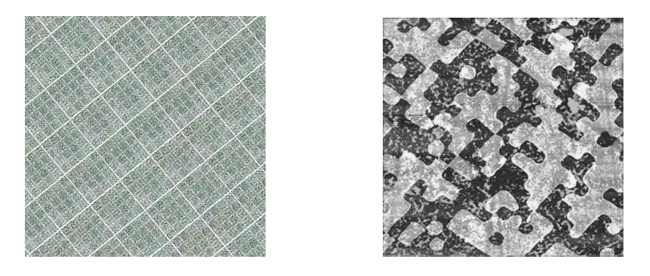 New storage tier brings advantages to data centers
New storage tier brings advantages to data centers
In the future, the vast majority of data will be stored in an active archive. With Cerabyte, data centers will be able to utilize high-performance storage for computing and tier data efficiently on accessible, permanent and sustainable ceramic-based storage, deploying exabyte-scale data center racks. The persistent and immutable media technology can hold data for extremely long periods without the need for periodic refreshes, data migrations, or fixity checks.
Due to its low access latency, the company is positioned to disrupt archive storage. Physical bits are ablated into recyclable ceramic-on-glass sheets, retaining data virtually forever with a zero-power footprint and without bit rot, even under extreme conditions.
- Semiconductor-like scaling: Firm’s technology roadmap builds on amortized semiconductor fabrication tool technology adapted for data storage use cases.
- Leverage existing ecosystem: Display glass, produced in high volumes, is used for firm’s ceramic-on-glass sheets, which are stacked inside LTO tape-sized cartridges leveraging existing library automation.
- High-performance storage: The company’s system encodes binary data readable by a scanning microscope, employing femtosecond lasers to create with each pulse millions of nanoscale holes in a ceramic layer using a DMD (digital micromirror device).
The company’s solution is available as a storage system prototype and is primed for commercialization. It has demonstrated end-to-end functionality in target environments. Interested customers can experience Cerabyte’s prototype and technology here.
The company was founded in 2022 by Christian Pflaum, Martin Kunze and Alexander Pflaum. It participated in the Intel Ignite accelerator program and has raised $10 million in seed funding to date.
Resources:
Cerabyte Technology
The Sustainable Preservation of Enterprise Data, Furthur Market Research WP
Cerabyte Market Positioning: Secondary Storage Demanding a New Improved Solution, Horison Information Strategies WP
Tiered Storage: Storage Optimization for the Zettabyte Era / A New Storage Tier is Needed, Horison Information Strategies WP
Video : Cerabyte for archival data
Video : Digital Data as Durable as Hieroglyphs
Video : Cerabyte for archival data
Video : Cerabyte’s Resilience
Video : Cerabyte TCO
Comments
From Cerabyte GmbH
The Cerabyte Nano Memory
The company Cerabyte, founded in 2022, is developing Ceramic Nano Memory a data storage technology featuring a sputtered deposited extremely durable ceramic nano layer with a broad absorption spectrum, a ‘grey ceramic’, which allows ultra-fast write with threshold as low as 0.1nJ per bit. The ceramic is deposited on both sides of a flexible ultrathin planar substrate with only 100um thick foldable glass (1) or 10um thick ribbon glass (2) for potential tape development. These substrates and the coating a ceramic nano layers leverage existing display glass production capacities of today 350 million m2 per year (3). Thus the company expects to achieve media cost below $1/TB by the end of this decade.
Cerabyte ceramic-on-glass sheets use ultra-thin glass as substrate material, which is cut to sheets of 9x9 cm, coated with a 10nm thin dark ceramic nanolayer comprising only 50-100 atom layers, forming the novel data carrier
The writing process is using ultra-short laser pulses in combination with off the shelf digital mirror devices (DMD) which is commonly used in video projectors and head-up displays. The combination of the laser with a DMD generates a laser beam matrix which permanently ablates the ceramic nano-layer and writes up to 2 million bits per pulse in parallel at high repetition-rates in the kHz range. This enables future writing speeds of 1+GB/s with less than 1W average power which is 3-4 times faster compared to LTO tape or HDD technology.
The reading process uses the same microscope optic, high-speed illumination and an ultrafast high-resolution image sensor with 500+ frames/second. The decoding of these image data into digital data is than performed by parallel processing via FPGA (Field Programmable Gate Array) thus enabling reading speeds of 1+GB/s, again outperforming HDDs by far. See video of the prototype system - Cerabyte from Vision to Reality
Both reading and writing are carried out across the substrate by scanning the microscope optics using high-speed XY stages kept in focus using a piezo driven auto focus system. This setup allows random access.
Multiple 9 cm by 9 cm Cerabyte sheets are stacked in individual cartridges to minimize volumetric storage volume. Cerabyte uses the external form factor of common magnetic tape cartridges, while media can be retrieved in a random-access regime achieving much shorter time to 1st byte compared to LTO tape.
Accelerated aging tests between -273°C to 500°C indicate potential storage lifetime in the millennia range. Furthermore, the data is not corrupted even when exposed to electromagnetic pluses, UV, or gamma rays.
Cerabyte employs a commercially available library unit utilizing a remote write architecture. The library will locate the and retrieve the cartridge, then unload and unstack the substrates for positioning the addressed substrate in the optical unit.
The Cerabyte prototype system with a single write and read head unit achieves 5MB/s write/read speeds. The 1st demo system for archiving customers is scheduled to be available for remote testing in 2024 with 100MB/s write/read speeds and a capacity of 1PB/rack with up to 10 robotic library racks. In 2025 a 20 rack system for cloud data centers will be launched with 1GB/s write/read speeds and a capacity of 10PB/rack, which increase over time and will achieve capacities attractive for hyperscalers by end of the decade.
The visionary roadmap foresees the usage of high-speed particle beam matrix beyond 2030, which will significantly decrease the nano-layer size reaching storage capacities in the exabyte range while boosting writing and reading speeds significantly.
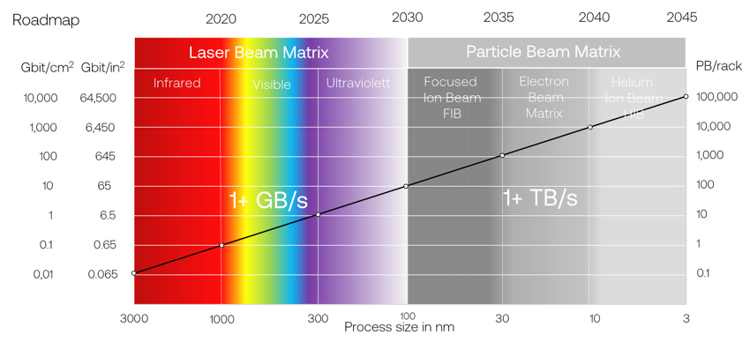 The roadmap until 2030 and beyond is strengthened by a comprehensive IP portfolio, comprising an extensive collection of international patents and patent applications covering storage media, writing/reading devices and high-density matrix formats underpin the company's commitment to technological leadership and innovation of cold data storage. The patent portfolio covers 80 % of global GDP, 85% of global data storage infrastructure, 67% of smartphone penetration and 49% of global population.
The roadmap until 2030 and beyond is strengthened by a comprehensive IP portfolio, comprising an extensive collection of international patents and patent applications covering storage media, writing/reading devices and high-density matrix formats underpin the company's commitment to technological leadership and innovation of cold data storage. The patent portfolio covers 80 % of global GDP, 85% of global data storage infrastructure, 67% of smartphone penetration and 49% of global population.
(1) https://www.corning.com/worldwide/en/innovation/materials-science/glass/Foldable-Glass.html
(2) https://www.neg.eo.jp/en/product/ep/glass-ribbon
(3) https://www.statista.com/statistics/i05744i/display-panel-production-capacity-type/
© 2024 www.cerabyte.com








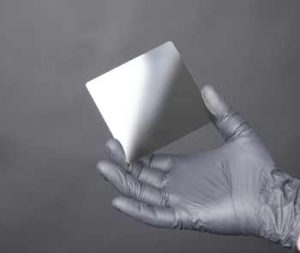
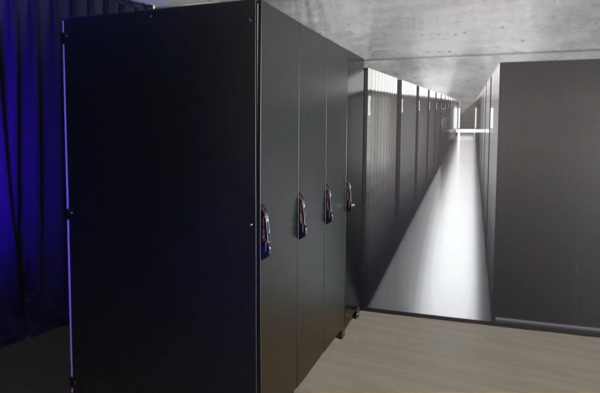



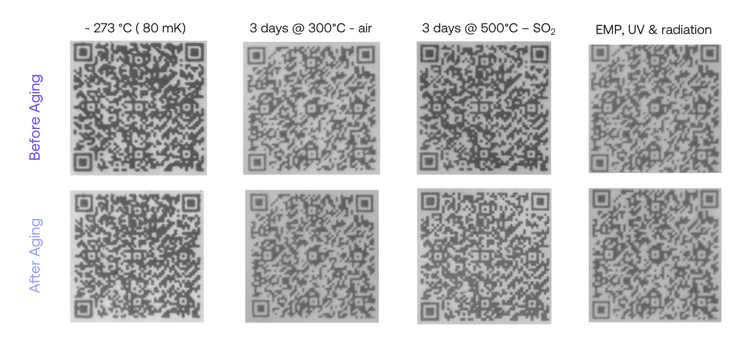
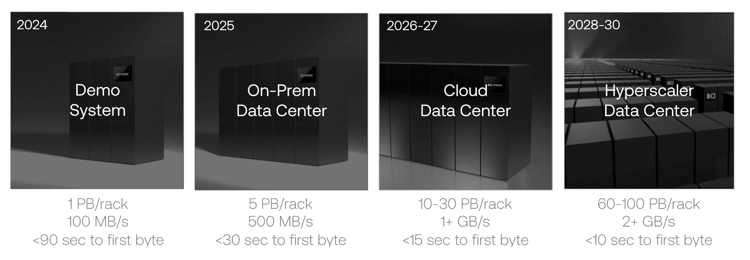






 Subscribe to our free daily newsletter
Subscribe to our free daily newsletter

